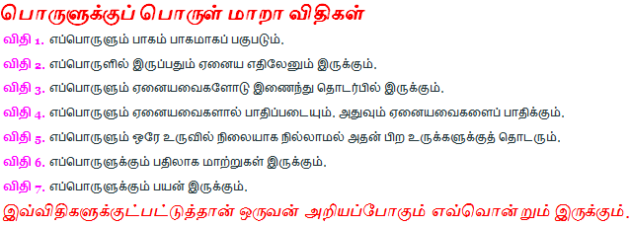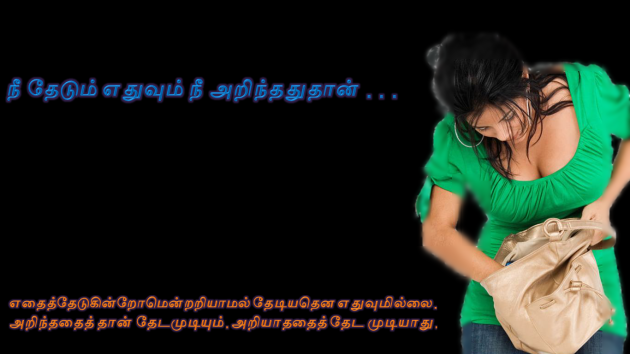| The Intellectual Rule Book |
| இந்த நூலில் இடம்பெற்றுள்ள கேள்விகளை உங்கள் ஆசிரியர்களிடம் கேட்டுவிடாதீர்கள்! ஆசிரியர்கள் ஓட்டம் பிடித்து விடுவார்கள்! Download |
பல் பற்றி உன் அறிவை வளர்த்துக்கொள்ள அறியப்பட வேண்டியவைகள்:
1. அதன் பாகங்கள் எவை?
2. அதிலிருப்பது, மற்ற எதிலிருக்கிறது?
3. அதனோடு இணைந்திருப்பவைகள் எவை?
4. அதைப் பாதிப்பவைகள் எவை?
5. அதன் உருக்கள் எவை?
6. அதற்குப் பதிலாக இருக்கும் மாற்றுகள் எவை?
7. அதனால் ஏற்படும் பயன்கள் எவை?
இவைகளிலெதையும் அறிந்திருக்காதவன் பல் பற்றி அறிவேதுமில்லாதவன்.
| The Intellectual Rule Book |
| இந்த நூலில் இடம்பெற்றுள்ள கேள்விகளை உங்கள் ஆசிரியர்களிடம் கேட்டுவிடாதீர்கள்! ஆசிரியர்கள் ஓட்டம் பிடித்து விடுவார்கள்! Download |
| பல் பற்றி ஒருவன் கூறவிருப்பவை: |
| •அது பாகம் பாகமாகப் பகுபடக்கூடிய ஒன்றாகும். •அதிலிருப்பது ஏனையவைகளிலும் இருக்கிறது. •அது ஏனையவைகளோடு இணைந்து தொடர்பில் இருக்கிறது. •அது ஏனையவைகளால் பாதிப்படைகிறது. அதுவும் ஏனையவைகளைப் பாதிக்கிறது. •அது ஒரே உருவில் நிலையாக நில்லாமல் அதன் பிற உருக்களுக்குத் தொடரக்கூடியது. •அதற்குப் பதிலாக மாற்றுகள் இருக்கின்றன. •அது பயனற்ற ஒன்றல்ல, தேவையான ஒன்றாகும். |
பல் பற்றி பள்ளி கல்லூரிகளில் பயின்றவன் கூறவிருப்பவைகளில் எவை பள்ளி கல்லூரிகளில் பயிலாதவனால் கூறமுடியாதவைகள்?
| Downloads: |
| எப்பொருளையும் பற்றிய உன் அறிவு எதிர்பாராததல்ல! The Expected Knowledge The Knowledge Expansion Manual |




_/_/_/_/_/_/_/_/_/_/_/_/_/_/_/_/_/_/_/_/_/_/_/_/_/_/_/_/_/_/_/_/
நாய்ப்பல் பற்றி அறிவு இருக்கிறதா உனக்கு?
நாய்ப்பல் பற்றி உன் அறிவை வளர்த்துக்கொள்ள அறியப்பட வேண்டியவைகள்:
1. அதன் பாகங்கள் எவை?
2. அதிலிருப்பது, மற்ற எதிலிருக்கிறது?
3. அதனோடு இணைந்திருப்பவைகள் எவை?
4. அதைப் பாதிப்பவைகள் எவை?
5. அதன் உருக்கள் எவை?
6. அதற்குப் பதிலாக இருக்கும் மாற்றுகள் எவை?
7. அதனால் ஏற்படும் பயன்கள் எவை?
_/_/_/_/_/_/_/_/_/_/_/_/_/_/_/_/_/_/_/_/_/_/_/_/_/_/_/_/_/_/_/_/
குதிரைப்பல் பற்றி அறிவு இருக்கிறதா உனக்கு?
குதிரைப்பல் பற்றி உன் அறிவை வளர்த்துக்கொள்ள அறியப்பட வேண்டியவைகள்:
1. அதன் பாகங்கள் எவை?
2. அதிலிருப்பது, மற்ற எதிலிருக்கிறது?
3. அதனோடு இணைந்திருப்பவைகள் எவை?
4. அதைப் பாதிப்பவைகள் எவை?
5. அதன் உருக்கள் எவை?
6. அதற்குப் பதிலாக இருக்கும் மாற்றுகள் எவை?
7. அதனால் ஏற்படும் பயன்கள் எவை?
_/_/_/_/_/_/_/_/_/_/_/_/_/_/_/_/_/_/_/_/_/_/_/_/_/_/_/_/_/_/_/_/
கழுதைப்பல் பற்றி அறிவு இருக்கிறதா உனக்கு?
கழுதைப்பல் பற்றி உன் அறிவை வளர்த்துக்கொள்ள அறியப்பட வேண்டியவைகள்:
1. அதன் பாகங்கள் எவை?
2. அதிலிருப்பது, மற்ற எதிலிருக்கிறது?
3. அதனோடு இணைந்திருப்பவைகள் எவை?
4. அதைப் பாதிப்பவைகள் எவை?
5. அதன் உருக்கள் எவை?
6. அதற்குப் பதிலாக இருக்கும் மாற்றுகள் எவை?
7. அதனால் ஏற்படும் பயன்கள் எவை?
_/_/_/_/_/_/_/_/_/_/_/_/_/_/_/_/_/_/_/_/_/_/_/_/_/_/_/_/_/_/_/_/
பூனைப்பல் பற்றி அறிவு இருக்கிறதா உனக்கு?
பூனைப்பல் பற்றி உன் அறிவை வளர்த்துக்கொள்ள அறியப்பட வேண்டியவைகள்:
1. அதன் பாகங்கள் எவை?
2. அதிலிருப்பது, மற்ற எதிலிருக்கிறது?
3. அதனோடு இணைந்திருப்பவைகள் எவை?
4. அதைப் பாதிப்பவைகள் எவை?
5. அதன் உருக்கள் எவை?
6. அதற்குப் பதிலாக இருக்கும் மாற்றுகள் எவை?
7. அதனால் ஏற்படும் பயன்கள் எவை?
_/_/_/_/_/_/_/_/_/_/_/_/_/_/_/_/_/_/_/_/_/_/_/_/_/_/_/_/_/_/_/_/
எருமைப்பல் பற்றி அறிவு இருக்கிறதா உனக்கு?
எருமைப்பல் பற்றி உன் அறிவை வளர்த்துக்கொள்ள அறியப்பட வேண்டியவைகள்:
1. அதன் பாகங்கள் எவை?
2. அதிலிருப்பது, மற்ற எதிலிருக்கிறது?
3. அதனோடு இணைந்திருப்பவைகள் எவை?
4. அதைப் பாதிப்பவைகள் எவை?
5. அதன் உருக்கள் எவை?
6. அதற்குப் பதிலாக இருக்கும் மாற்றுகள் எவை?
7. அதனால் ஏற்படும் பயன்கள் எவை?
_/_/_/_/_/_/_/_/_/_/_/_/_/_/_/_/_/_/_/_/_/_/_/_/_/_/_/_/_/_/_/_/
சிங்கப்பல் பற்றி அறிவு இருக்கிறதா உனக்கு?
சிங்கப்பல் பற்றி உன் அறிவை வளர்த்துக்கொள்ள அறியப்பட வேண்டியவைகள்:
1. அதன் பாகங்கள் எவை?
2. அதிலிருப்பது, மற்ற எதிலிருக்கிறது?
3. அதனோடு இணைந்திருப்பவைகள் எவை?
4. அதைப் பாதிப்பவைகள் எவை?
5. அதன் உருக்கள் எவை?
6. அதற்குப் பதிலாக இருக்கும் மாற்றுகள் எவை?
7. அதனால் ஏற்படும் பயன்கள் எவை?
_/_/_/_/_/_/_/_/_/_/_/_/_/_/_/_/_/_/_/_/_/_/_/_/_/_/_/_/_/_/_/_/
புலிப்பல் பற்றி அறிவு இருக்கிறதா உனக்கு?
புலிப்பல் பற்றி உன் அறிவை வளர்த்துக்கொள்ள அறியப்பட வேண்டியவைகள்:
1. அதன் பாகங்கள் எவை?
2. அதிலிருப்பது, மற்ற எதிலிருக்கிறது?
3. அதனோடு இணைந்திருப்பவைகள் எவை?
4. அதைப் பாதிப்பவைகள் எவை?
5. அதன் உருக்கள் எவை?
6. அதற்குப் பதிலாக இருக்கும் மாற்றுகள் எவை?
7. அதனால் ஏற்படும் பயன்கள் எவை?
_/_/_/_/_/_/_/_/_/_/_/_/_/_/_/_/_/_/_/_/_/_/_/_/_/_/_/_/_/_/_/_/
குரங்குப்பல் பற்றி அறிவு இருக்கிறதா உனக்கு?
குரங்குப்பல் பற்றி உன் அறிவை வளர்த்துக்கொள்ள அறியப்பட வேண்டியவைகள்:
1. அதன் பாகங்கள் எவை?
2. அதிலிருப்பது, மற்ற எதிலிருக்கிறது?
3. அதனோடு இணைந்திருப்பவைகள் எவை?
4. அதைப் பாதிப்பவைகள் எவை?
5. அதன் உருக்கள் எவை?
6. அதற்குப் பதிலாக இருக்கும் மாற்றுகள் எவை?
7. அதனால் ஏற்படும் பயன்கள் எவை?
_/_/_/_/_/_/_/_/_/_/_/_/_/_/_/_/_/_/_/_/_/_/_/_/_/_/_/_/_/_/_/_/
சொத்தைப்பல் பற்றி அறிவு இருக்கிறதா உனக்கு?
சொத்தைப்பல் பற்றி உன் அறிவை வளர்த்துக்கொள்ள அறியப்பட வேண்டியவைகள்:
1. அதன் பாகங்கள் எவை?
2. அதிலிருப்பது, மற்ற எதிலிருக்கிறது?
3. அதனோடு இணைந்திருப்பவைகள் எவை?
4. அதைப் பாதிப்பவைகள் எவை?
5. அதன் உருக்கள் எவை?
6. அதற்குப் பதிலாக இருக்கும் மாற்றுகள் எவை?
7. அதனால் ஏற்படும் பயன்கள் எவை?
_/_/_/_/_/_/_/_/_/_/_/_/_/_/_/_/_/_/_/_/_/_/_/_/_/_/_/_/_/_/_/_/
கரடிப்பல் பற்றி அறிவு இருக்கிறதா உனக்கு?
கரடிப்பல் பற்றி உன் அறிவை வளர்த்துக்கொள்ள அறியப்பட வேண்டியவைகள்:
1. அதன் பாகங்கள் எவை?
2. அதிலிருப்பது, மற்ற எதிலிருக்கிறது?
3. அதனோடு இணைந்திருப்பவைகள் எவை?
4. அதைப் பாதிப்பவைகள் எவை?
5. அதன் உருக்கள் எவை?
6. அதற்குப் பதிலாக இருக்கும் மாற்றுகள் எவை?
7. அதனால் ஏற்படும் பயன்கள் எவை?
_/_/_/_/_/_/_/_/_/_/_/_/_/_/_/_/_/_/_/_/_/_/_/_/_/_/_/_/_/_/_/_/
எலிப்பல் பற்றி அறிவு இருக்கிறதா உனக்கு?
எலிப்பல் பற்றி உன் அறிவை வளர்த்துக்கொள்ள அறியப்பட வேண்டியவைகள்:
1. அதன் பாகங்கள் எவை?
2. அதிலிருப்பது, மற்ற எதிலிருக்கிறது?
3. அதனோடு இணைந்திருப்பவைகள் எவை?
4. அதைப் பாதிப்பவைகள் எவை?
5. அதன் உருக்கள் எவை?
6. அதற்குப் பதிலாக இருக்கும் மாற்றுகள் எவை?
_/_/_/_/_/_/_/_/_/_/_/_/_/_/_/_/_/_/_/_/_/_/_/_/_/_/_/_/_/_/_/_/
சிறுத்தைப்பல் பற்றி அறிவு இருக்கிறதா உனக்கு?
சிறுத்தைப்பல் பற்றி உன் அறிவை வளர்த்துக்கொள்ள அறியப்பட வேண்டியவைகள்:
1. அதன் பாகங்கள் எவை?
2. அதிலிருப்பது, மற்ற எதிலிருக்கிறது?
3. அதனோடு இணைந்திருப்பவைகள் எவை?
4. அதைப் பாதிப்பவைகள் எவை?
5. அதன் உருக்கள் எவை?
6. அதற்குப் பதிலாக இருக்கும் மாற்றுகள் எவை?
7. அதனால் ஏற்படும் பயன்கள் எவை?
1. The Teeth and Their Parts:
Each tooth has two main parts, the crown and the root.
The crown and the root meet at the neck of the tooth, which is normally just below the gum margin.
The crown
This is the part of the tooth that we see in the mouth.
It is made up of the enamel, dentine and pulp.
The appearance of teeth varies in shape and size.
The front incisor teeth have a straight edge as a cutting tool.
The canine or eye teeth are the pointed long teeth between the incisor and premolar teeth.
The pre-molar and molar teeth are larger and have cusps.
A cusp is the raised pointed part of the chewing surface of a tooth.
The presence of large cusps on pre-molar and molar teeth marks the main difference between them and the front teeth.
Pre-molar teeth (bicuspids) have two cusps.
Molar teeth each have four or more cusps.
The four permanent lower incisor teeth each erupt with three small cuspettes that resemble a serrated edge. These cusps wear down with use and the teeth remain with a straight edge.
The four permanent upper incisors may erupt with three very small cuspettes. These are much less obvious than those on the lower incisors. They are also normally worn away to form a straight edge.
Enamel
The enamel is the white hard covering over the crown of the tooth.
It is shaped into cusps, fissures and pits in premolar and molar teeth.
It is the hardest material in the body and does not have a nerve supply.
Chipping or damage to enamel only will not be painful.
It also does not have a blood supply.
This results in a chipped tooth remaining exactly as it is.
Enamel cannot heal or repair as bone or dentine can.
Dentine
Dentine is a cream coloured hard material that makes up the bulk of the tooth.
It is covered by enamel on the crown, and by cementum on the roots.
The dentine surrounds and protects the nerves and blood vessels (pulp) in the crown and roots.
Dentine is alive or vital in as much as more dentine can be formed, and it can register pain.
A protective layer of secondary dentine can be layed down over the pulp.
This happens in response to caries, attrition, abrasion, erosion, or fracture of a tooth, when the dentine becomes exposed.
The tooth becomes sensitive to temperature changes and feels painful, when the dentine is exposed in the above mentioned ways.
Pulp
The nerves and blood vessels of the tooth are called the pulp.
The pulp occupies the root canals, and the pulp chamber in the crown of the tooth.
When it is exposed to infection by decay or injury it will die and cause severe pain. An abscess will develop on the root.
The tooth will have to be extracted if a root canal treatment is not performed to save it.
The roots
The roots are embedded in the tooth socket in the jaw bone.
The front incisor and eye-teeth each have a single root.
Pre-molar teeth (bicuspids) have one or two roots.
The molar teeth can have two or three roots.
Each root has a root canal for the nerves and blood vessels to pass through.
Roots are covered by cementum and held in place by the periodontal ligament.
Cementum
The cementum is a thin calcified covering of the roots.
It meets the enamel at the neck of the tooth.
It has no nerve supply.
The cementum covers the dentine of the roots.
It is attached to the periodontal ligament.
Periodontal membrane or ligament
The periodontal ligament attaches the roots to the alveolar bone of the jaw.
It has both a nerve and blood supply
The ligament provides an elastic cushion between the tooth and the bone. Slight movement of a tooth is made possible by the ligament.
Teeth are not rigidly joined to bone. There is flexibility.
2. Tooth Names and Positions.
A. Baby Teeth
Front Teeth:
A. Central incisor
B. Lateral incisor
C. Canine or eye tooth
D. First molar
E. Second molar
1. Central incisor
2. Lateral incisor
3. Canine or eye tooth
4. First premolar
5. Second premolar
6. First Molar
7. Second Molar
8. Third Molar Or Wisdom Tooth
Teeth are one of the important part of our body. Teeth are one of the functional component of mouth. Mouth is made up of lips, jaws, palate, gums and tongue. Teeth play a very vital role in digestion of food. Teeth prepare the food for easy digestion by means of crushing and milling processes.
In Humans, there are two type of dentition:-
1. Deciduous or Milk teeth
2. Permanent teeth
Milk teeth erupts (appears in the mouth), when the child is about 6 months of age. Permanent teeth erupts at about 6 years of age. In addition to food chewing, teeth are also helpful in speech and communication.
Anatomy of Tooth
Tooth is a calcified structure as like bone, embedded in jaw bone and surrounded by gums. We can broadly divide the tooth in two parts- Crown and Root(s). Crown is the part of tooth that is seen in mouth and Root is the part of tooth that is embedded in jaw bone.
Basically, 4 types of dental tissues made the tooth, namely Enamel, Dentin, Cementum and Pulp.
Enamel
Enamel is the first creamy white layer of tooth which is dead, and the hardest part of our body.
Dentin
Dentin is the second layer of tooth, yellowish-brown in color, forms main bulk of tooth, vital (alive layer), highly elastic and main load bearing layer of tooth during chewing.
Cementum
Cementum covers the root surface of tooth. Cementum is hypersensitive part of tooth.
Pulp
Pulp is highly sensitive area of tooth, full of nerve and blood area. It finds in the centre of tooth.
Numbering and Nomenclature of teeth in Human Jaw
In milk dentition, there are 20 number of teeth present, whereas in permanent dentition 32 teeth are present. Milk teeth last from 6 month to 2.5 to 3 years of age, whereas permanent teeth last from 6 years to 13 years of age.
We normally have 4 types of teeth in dental arches:-
Incisors teeth
Total 8 in numbers (4 in each jaws). Incisors teeth are used to incise or cut the food.
Canine teeth
Total 4 in numbers (2 in each jaws). Canine teeth are used to tear the food (more prominent in non vegetarian people).
Premolar teeth
Total 8 in number (4 in each jaws). Premolar teeth are used in partial chewing of cut and tear food.
Molar teeth
4 to 6 in each jaws, depend upon presence of 3rd molar. Molar teeth are helpful in major chewing of food.
Facts about Teeth
1. Milk dentition not having premolar teeth so all the premolars are always permanent.
2. Milk dentition not having wisdom tooth.
3. 3rd molar is also known as WISDOM TOOTH because it is usually appears at the age of maturity near about 17 years to 25 years.
4. It is unpredictable that how many wisdom tooth will appear in the mouth of a person.
5. When we say 32 teeth, it means all the 4 wisdom tooth are present.
6. Enamel is hardest part of our body even bone comes after.
7. Enamel is dead layer, that’s why any trauma, fracture, cavity not leads to pain.
8. Because of deadness of Enamel it is never regenerated again by the body with the progression of age. Enamel will reduce in amount and thickness as well.
9. With the age, as the Enamel get wear off with the use; underlying dentin comes up and showing it’s yellowish-brown color that’s why with the progressing age tooth becomes yellow in color.
� � � � � � � � £� ¯� � � � � � � ¯� � � � � ¯� � � � ¯ � � � � ´� ¯� � � � � ¿� � � � � ¾� � � � ¯.